

'is$$anonymous$$ine?' mean 'I am owner?' so that game logic have to take care about who created the object. Like Jerdak commented, it should be present in UnityScript without modification. If use Instantiate and use RPC to other Unity instances to create the object, than each Unity instance will create the object in local scene, so each Unity instance will be the owner, we having more owners. It's networkView.isMine (not NetworkView.ismine). If use Network.Instantiate, the owner is Unity instance sending call to other Unity instances to create object. The owner is the creator of object, aka Unity instance (editor,player) which create (instantiate) the object from the project on the scene. The idea is the object having attached NetworkView have an owner. Networking is not an easy thing and there are more ways to create and control objects from a machine/unity instance to other. You have to read a bit more the tutorials about how the networking it's working on Unity.

When I open to instances of the game (one in the editor and one in the player), it seems as though the game is wanting to duplicate the player and camera, causing one screen to control the player from the other, and vice versa.Ĭc.transform.Translate(Vector3(0, 0, 1) * speed * ltaTime) Ĭc.transform.Translate(Vector3(0, 0, -1) * speed * ltaTime) Ĭc.transform.Rotate(Vector3(0, 1, 0) * rotateSpeed) Ĭc.transform.Rotate(Vector3(0, -1, 0) * rotateSpeed) ĭoes anyone know where I might be going wrong?. So far, everything is working fairly well. I am working on a multiplayer game that is being created within a network.


 0 kommentar(er)
0 kommentar(er)
